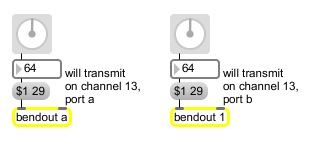Examples

Letter argument transmits to only one port....... Otherwise number specifies both port and channel
Transmit MIDI pitch bend messages
| Name | Type | Opt | Description |
|---|---|---|---|
| a-z | symbol | opt | Specifies the port for transmitting MIDI pitch bend messages. Channel numbers greater than 16 received in the right inlet will be wrapped around to stay within the 1-16 range. If there is no argument, bendout initially transmits out port , on MIDI channel 1. |
| a-z and int | list | and A letter and number combination (separated by a space) indicates a port and a specific MIDI channel on which to transmit pitch bend messages. Channel numbers greater than 16 will be wrapped around to stay within the 1-16 range. | |
| (MIDI name) | symbol | opt | The name of a MIDI output device may be used as the first argument to specify the port. |
| MIDI-channel | int | A number alone can be used in place of a letter and number combination. The exact meaning of the channel number argument depends on the channel offset specified for each port in the MIDI Setup dialog. |
| int | input [int] |
In left inlet: The number is transmitted as a MIDI pitch bend value on the specified channel and port. Numbers are limited between 0 and 127. In right inlet: The number is stored as the channel number on which to transmit the pitch bend messages. |
| (inlet1) | MIDI-channel [int] |
In right inlet: The number is stored as the channel number on which to transmit the pitch bend messages. |
| float | input [float] |
Converted to . |
| anything | MIDI-port [list] |
Performs the same function as .. |
| (mouse) | Double-clicking on a bendout object shows a pop-up menu for choosing a MIDI port or device. | |
| port | MIDI-port [symbol] |
In left inlet: The word , followed by a letter or the name of a MIDI output port or device, specifies the port used to transmit MIDI messages. The word is optional and may be omitted. |
